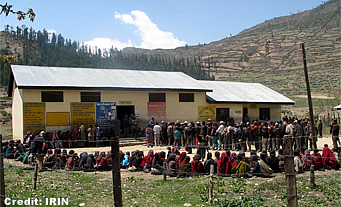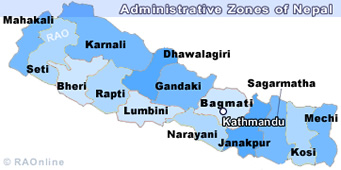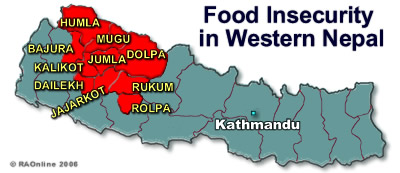|
Development
in Nepal: Reports on Food Crisis
|
 |
Nepal Development |
|
 |
Nepal Development |
|
|
 |
|
NEPAL:
2006 - Food crisis in the west growing - NGOs
|
KATHMANDU,
8 May 2006, IRIN
International
development agencies in Nepal are seriously concerned about an acute food
shortage in several hill and mountain districts in the western region of
the Himalayan kingdom.
 |
Queueing for government food - many parts of Nepal do not grow enough to
feed the population
|

|
|
The
Dutch development agency (SNV) and Action Contre la Faim (ACF), the French
international NGO, have said that lack of food is very visible in several
remote districts of the impoverished Karnali province in northwestern Nepal.
Nepal's
worst food deficit districts: Mugu, Humla, Kalikot, Jumla and Dolpa - all in Karnali, where most Nepalese
live on less than US $1 day - have had a
history of food shortages for many decades.
Food
production from farming in these districts barely lasts six months each
year. But now the situation has become much worse with significantly less
food being produced, recent assessments show. The region suffered the
worst drought in 40 years from February to March 2006.
"Due
to a lack of rains, all the fields have gone to waste and look barren at
a time when they were supposed to be filled with greenery and crops," said
SNV's Rick van Keulen, who went to Humla to observe the food security situation
there.
 |
| "There
is no more food stock left with most families. We will be launching our
emergency supplementary food feeding programme as soon as possible," explained
Mireille Seneclauze, head of ACF in Nepal.
ACF,
which had conducted a food security assessment in 10 villages around Humla
and Mugu earlier this year, also reported that there was widespread acute
malnutrition in the area, particularly affecting children. |
|
Nepal
already has one of the world's highest rates of chronic malnutrition: affecting
nearly 63 percent of Nepalese children, according to the 2004 UN Human
Development Report on Nepal.
"The
main aid agencies for Nepal have not given much attention to this issue,"
said Chandra Shahi, a member of the Nepalese parliament from Mugu district.
He has been lobbying the newly formed Nepalese cabinet in the capital,
Kathmandu, to act to end the hunger.
"Many
villagers don't even have a single wheat grain in their houses, they are
now forced to eat aromatic and herbal plants to survive," he added.
Until
now, the Ministry of Local Development (MLD) had been flying rice from
the capital to the isolated region, but these supplies are limited to the
district centres and hungry villagers often have to walk for up to six
days to get to the food aid.
The
UN's World Food Programme (WFP), along with the Swiss Development Corporation
(SDC) and UN's Food and Agriculture Organisation (FAO), has sent assessment
teams to seven of the food deficit districts to collect information and
will present the findings in 10 days.
"We
are starting to have a contingency plan for a possible or potential response,"
said Jean Pierre de Margerie, acting director of WFP in Nepal.
Source:IRIN 2006
Copyright
Ⓒ UN Office for the Coordination of Humanitarian Affairs 2006
[
This report does not necessarily reflect the views of the United Nations] |
 |
Integrated
Regional Information Networks (IRIN), part of the UN Office for the Coordination
of Humanitarian Affairs (OCHA)
| more information |
 |
| Links |
 |
 |
 |
External
link |
|






